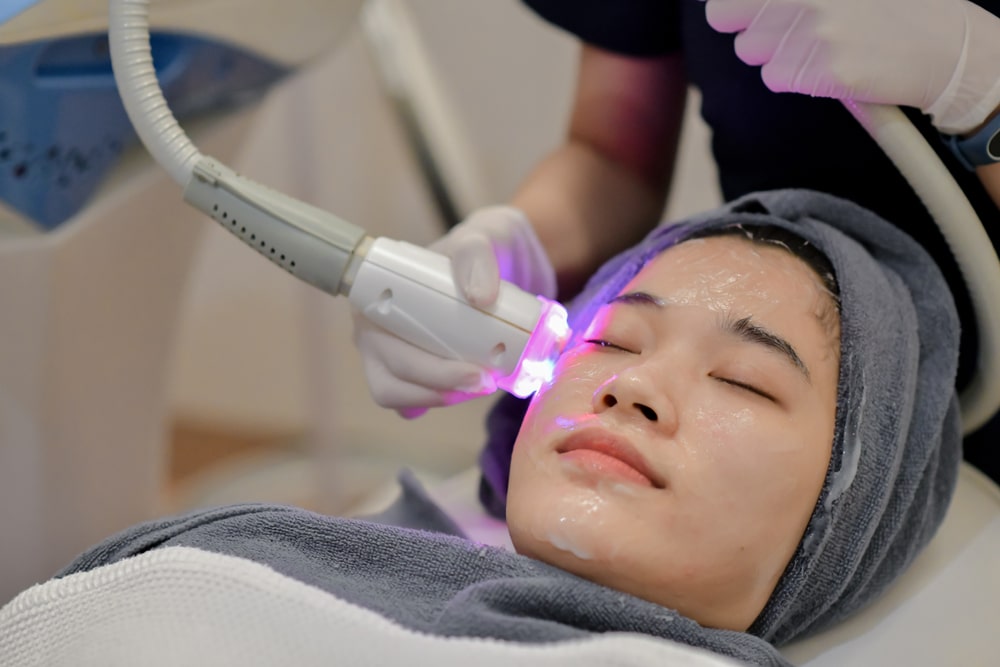Just a few hours after spending time in the sun, your skin can become red and inflamed with a sunburn. Eventually, that sunburn will fade, and you may think your skin is back to normal. But each sunburn contributes to cumulative sun damage, and severe sunburns can permanently damage your skin cell DNA. Over time, this sun damage (a.k.a. photoaging) causes pigmentation, wrinkles, and dullness.
Your Dermatologist may recommend a sun-damaged skin treatment to improve the appearance of photoaged skin. Here's how sun damage works and what you can do to minimize its effects.
How the Sun Damages Skin
Ultraviolet (UV) radiation from the sun can take a massive toll on your skin. When UV rays hit your skin, they damage healthy skin cells. This can cause immediate signs of sun damage—such as tanned skin and sunburns—and cellular damage, which isn't visible right away but leads to gradual change.
With time, the visible effects of sun damage become more pronounced. Signs of sun-damaged skin can include:
- Pigmentation (e.g., age spots and melasma)
- Fine lines and wrinkles
- Decreased elasticity
- Dullness and blotchiness
- Rough skin texture
- Actinic keratoses (rough, scaly patches)
- Broken capillaries or spider veins
- Redness
Sun damage also increases the risk of skin cancer, so some people may develop cancerous lesions and growths.
6 Sun-Damaged Skin Treatments
You can't reverse skin cell damage, but with the right treatment, you can improve the appearance of sun-damaged skin. Ask your Derm about the best sun-damaged skin treatment for you during your next appointment or annual skin check.
1. Chemical Peels
If you use skin care products that contain beta-hydroxy acids and alpha-hydroxy acids, you're probably familiar with chemical exfoliation. It loosens dead skin cells to reveal a fresh, healthy layer of skin. Chemical peels work similarly, though they're more concentrated than over-the-counter products.
A chemical peel removes the skin's outermost layer. This can improve skin tone and texture, tackling sunspots, actinic keratosis, and rough, lackluster complexions. Some chemical peels can worsen hyperpigmentation in people with darker skin, however.
2. Microdermabrasion
Microdermabrasion is a physical exfoliation treatment. Using a hand-held device, your Derm will "sand down" the top layer of skin to smooth out uneven skin and stimulate new skin cell growth. This helps buff away dead skin cells, improving dullness, roughness, and pigmentation.
Unlike some treatments for sun-damaged skin, microdermabrasion is suitable for all skin tones. However, it may not be an option if you have active acne, eczema, or psoriasis.
3. Laser Resurfacing
Laser therapies mainly work by removing the skin's outer layer to let newer, often younger-looking skin come to the surface. Laser resurfacing is minimally invasive and helps improve the look and feel of skin with focused, high-energy beams of single-colored light. It's commonly used to improve concerns like fine lines, spider veins, scars, and age spots. Some lasers also stimulate collagen production.
4. Intense Pulsed Light (IPL)
Light from the sun and tanning beds can damage your skin, but not all light is harmful. Some light sources benefit the skin, such as the light used in IPL therapy, or photofacials.
In IPL treatments, a machine emits brief pulses of a broad spectrum of light wavelengths into your skin. The light is converted to heat, which passes through the top layer of skin and targets its deeper layers. These treatments mainly improve concerns related to skin pigmentation and veins, such as age spots, hyperpigmentation, redness, and burst capillaries. IPL also stimulates collagen production.
Similar to chemical peels, IPL may not be the best choice for darker skin tones.
5. Fillers and Neurotoxins
Wrinkles, fine lines, and loss of elasticity can occur over time, though sun damage can cause them to show up prematurely. Injectable cosmetic treatments like dermal fillers and neurotoxins like Botox can help.
Fillers contain ingredients like Hyaluronic Acid to add volume and give the appearance of a more lifted face by addressing fine lines, wrinkles, and loss of elasticity.
Injectable neurotoxins like Botox work by blocking nerves that make muscles contract. When those facial muscles relax, it softens the appearance of wrinkles and fine lines.
6. Skin Care
In addition to in-office treatments, your Esthetician or Derm can help you build a regular skin care routine to address visible sun damage. The American Academy of Dermatology recommends using a moisturizer, prescription-strength Retinoid, and sunscreen to combat the visible signs of sun damage. Retinoids increase skin cell turnover and collagen production, which can help fade dark spots and smooth wrinkles.
Sunscreen protects the skin from the sun's rays, which are a major contributor to premature aging. Sunscreens formulated with antioxidants, like EltaMD UV Clear Broad-Spectrum SPF 46, also help improve skin tone and protect the skin from harmful free radicals.
Preventing Sun Damage for a Lifetime of Healthy Skin
Preventing sun damage from occurring in the first place is the simplest way to support healthy, radiant skin. Here's how to get ahead of sun damage:
- Seek shade, especially when the sun is strongest.
- Wear clothes and accessories that cover your skin, such as long sleeves, wide-brimmed hats, and sunglasses.
- Use sunscreen daily—even when it's rainy or cloudy—to protect against damaging UV rays.
- Avoid tanning.
- See a Derm for an annual skin check.
A combination of prevention, treatment, and daily maintenance can help you achieve your skin goals and keep you feeling comfortable and confident. Your skin is with you for a lifetime, so give it the TLC it deserves!
